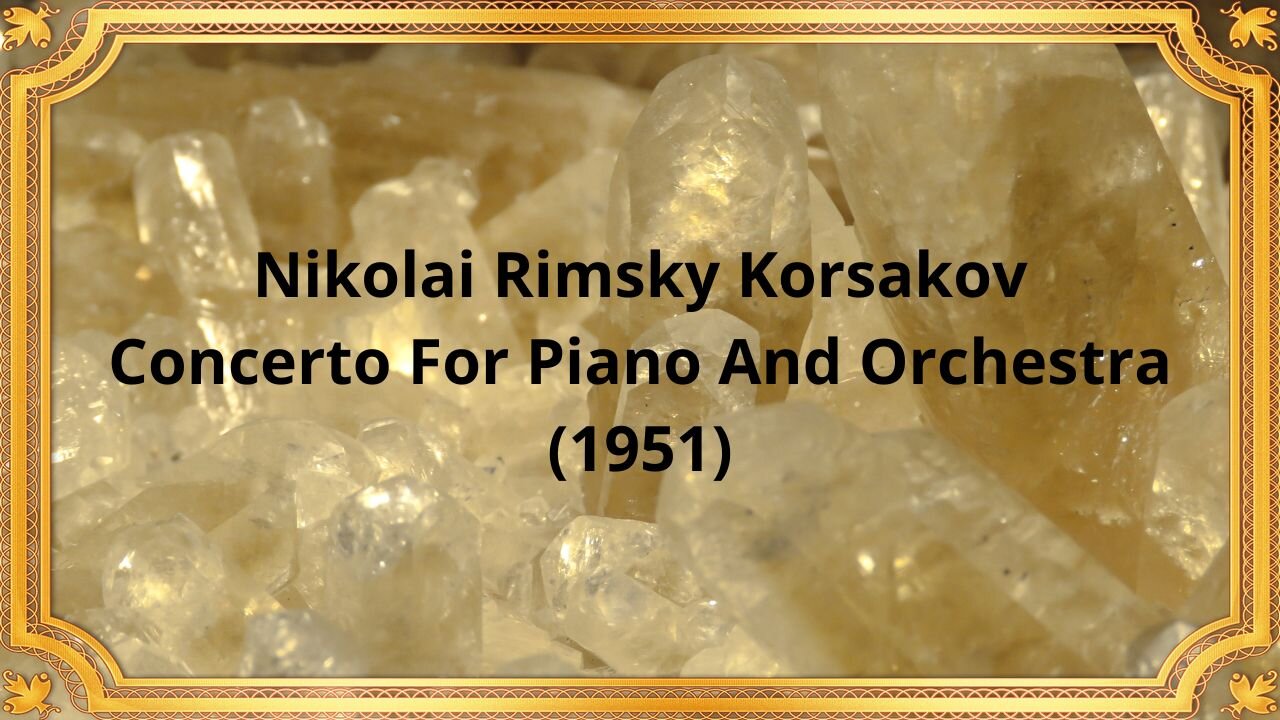Premium Only Content

Nikolai Rimsky Korsakov Concerto For Piano And Orchestra (1951)
#NikolaiRimskyKorsakov #PianoAndOrchestra #ClassicalMusic #RomanticEra #RussianComposers #MusicalComposition #MusicAnalysis #SymphonicMusic #MusicAppreciation
Publication date 1951
PAUL BADURA-SKODA, Piano
VIENNA SYMPHONY ORCHESTRA
conducted by HENRY SWOBODA
Nikolai Rimsky-Korsakov, a prominent figure in Russia's musical history and one of the mighty handful, is celebrated for his distinctive compositional style. One of his lesser-known, yet equally captivating works, is the Concerto for Piano and Orchestra in C-sharp minor, Op. 30. This intriguing piece offers a glimpse into Rimsky-Korsakov's innovative approach to orchestration and thematic development.
The concerto, composed in the year 1883, is a single-movement work, which was quite unconventional for the era it emerged from. It is based on a simple, folk-like theme, stated at the onset by the solo piano. This theme, steeped in the flavor of Russian folk music, is the foundation upon which the entire concerto is built.
The concerto begins with a solo piano introducing the main theme in a serene, almost meditative manner. The orchestra then takes over, expanding on the theme, giving it more depth and complexity. Here, Rimsky-Korsakov's skill in orchestration shines brightly, as he weaves a rich tapestry of sound, skilfully interlacing the piano and orchestral parts.
The middle section of the concerto is characterized by a more turbulent, dramatic mood. The piano part becomes more virtuosic, with fast, cascading runs and bold, rhythmic chords. The orchestra responds in kind, with swelling dynamics and intense thematic development.
Towards the end, the mood softens, and the main theme is revisited, this time in a more reflective light. The piano and orchestra engage in a tender dialogue, reminiscing the theme with a sense of nostalgia. The concerto concludes with a dramatic coda, where the theme is stated one last time with full orchestral force, bringing the work to a triumphant close.
Rimsky-Korsakov's Concerto for Piano and Orchestra stands as an intriguing example of his compositional style. The work beautifully showcases his ability to develop a simple theme into a complex and captivating musical narrative. Moreover, his innovative approach to orchestration, blending the piano and orchestra seamlessly, makes this concerto a gem worth exploring.
In conclusion, even though Rimsky-Korsakov's Concerto for Piano and Orchestra may not be as well-known as his other works, it still embodies the essence of his musical genius. It is a work that beautifully melds simplicity with complexity, tradition with innovation, and most importantly, melody with harmony.
-
 32:30
32:30
Classical music_Music Inspiration
1 month agoArturo Toscanini Grand Canyon Suite
1001 -
 44:41
44:41
The Officer Tatum
1 hour agoLIVE: Trump GIVES ORDER To Release Any Credible Evidence, Shane Gillis at the ESPY's + MORE | EP 141
1.16K1 -
 UPCOMING
UPCOMING
The HotSeat
29 minutes agoLet's Get Back To Business, Democrats are LOSING!
-
 LIVE
LIVE
Pop Culture Crisis
1 hour agoColdplay Exposes CHEATERS! Israel Boycotts SUPERMAN, Justin Bieber Mooching Off Hailey | Ep. 879
409 watching -
 LIVE
LIVE
charwinslow
4 hours agofinishing Fire Emblem: Blazing Blade - HECTOR HARD MODE!
91 watching -
 16:30
16:30
Brad Polumbo
6 hours agoCreepy “trans” star Lilly Tino has learned NOTHING! | NORMAL GAYS react
1.54K1 -
 8:00
8:00
Freedom Frontline
2 hours agoJake Tapper Just HUMILIATED Tim Walz on CNN With Simple Questions
1.59K2 -
 1:40:43
1:40:43
Benny Johnson
3 hours ago🚨White House Press Briefing LIVE Right Now: Karoline Leavitt Reacting to Massive New Trump News
36.8K28 -
 1:20:47
1:20:47
Russell Brand
3 hours agoRoyal Cover-Up? The Final Chapter of Diana’s Death - SF616
113K39 -
 3:35:49
3:35:49
Right Side Broadcasting Network
5 hours agoLIVE REPLAY: White House Press Secretary Karoline Leavitt Holds a Press Briefing - 7/17/25
104K30